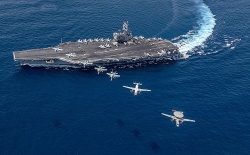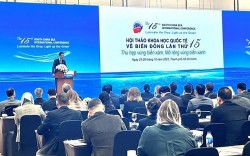
Ambiguous, illegitimate maritime militia: A factor constitutes to 'Grey zone' in the East Sea (Part II)
Latest
(Part 2)
 |
| Journalists on board a Philippine Coast Guard ship take photos of a Chinese Coast Guard ship during a mission to supply troops stationed at a stranded Philippine boat in the East Sea, September 8, 2023. (Source: REUTERS/Jay Ereno) |
Despite Beijing's denials,the West has little skepticism about what the US Department of Defense calls China's armed maritime militia (PAFMM), a 'powerful tool' of China's ambitions in the South China Sea.
Former Joint Intelligence Center - US Pacific Command operations division director, Mr. Carl O. Schuster, said that the Chinese maritime militia (PAFMM) have automatic weapons on board, and their solid steel hulls make them very dangerous at close range. The boat has a maximum speed of 18 to 22 knots/hour, 90% faster than conventional fishing boats.
In a report published in 2020, the US Department of Defense said that China has 84 maritime militia ships, all assigned to a unit operating on Hainan Island to manage. "PAFMM is one of China's professional forces, paid independently and not affiliated with commercial fishing obligations. Their members are recruited from veterans."
The "half-truth" story
A Russian proverb says, "Half the truth is not the truth." Some Chinese scholars, such as Chen Xiangmiao and Lei Xiaolu, commented that Vietnamese maritime militia hindered China's activities and were equipped with weapons. The truth is that Vietnamese legal and official defense documents have clear and transparent regulations on the marine militia and self-defense force position.
Specifically, Vietnam's 2009 Law on Militia and Self-Defense stipulates, "Maritime militia and self-defense force means a force within the core militia and self-defense force organized in coastal communes, island communes and in agencies and organizations with vessels operating at sea to perform tasks on Vietnam's sea areas."
Vietnam's latest National Defense White Paper in 2019 also clearly states that the maritime militia and self-defense force is part of the militia and self-defense organization. In peacetime, militia and self-defense forces generally have the task of production and participation in maintaining sovereignty, territorial integrity, and border security.
Meanwhile, China's maritime militia is an entirely different story. First, its nature is ambiguous and illegitimate. China's official security and national defense documents do not mention "maritime militia," such as the 2011 Regulations on Militia Work, the 1997 National Defense Law of the People's Republic of China, or its version of the Law Latest National Defense in 2020.
China's first National Defense White Paper in 1998 and the latest version in 2019 also do not mention maritime militia, although both mention militia. China also publicly declared that it does not own a naval militia. Specifically, at the press conference of the Chinese Ministry of Foreign Affairs in April 2016, responding to a reporter's question whether China used fishing vessels to promote maritime claims, Spokesperson Lu Kang said there was no grounds to facilitate that.
Most recently, in March 2021, when the Philippines accused China of deploying maritime militia at Whitsun Reef, the Chinese Embassy in the Philippines stated, "Chinese fishing vessels are taking shelter due to rough seas. There is no maritime militia in China."
Second, the force was present in at least eight collisions with countries in the South China Sea since 2009. Precisely, the Impeccable ship incident in 2009, The 2012 Scarborough Shoal confrontation, The installation of the HD-981 oil rig in 2014, the Besieged Thi Tu island in 2018, The HaiYang Geological 8 ship violated the main beach in 2019, Gathering a large number of boats at Whitsun Reef in early 2021; threatening the Philippine research ship M/V DA BFAR in 2022; Preventing Philippine supply ships at Second Thomas Shoal in 2023.
Most importantly, China's maritime militia is enforcing the "cow tongue line" claim, which is considered excessive and has no legal basis. In the case between the Philippines and China in the South China Sea in 2016, the arbitration court rejected the claims of historical rights, sovereign rights, and jurisdiction over the waters inside the "nine dotted line"
Development direction
According to "China Daily," in 2013, China had 439,000 motorized fishing vessels operating at sea and 21 million fishermen, ranking first globally. This is a massive resource for China to deploy maritime militia activities. In an interview with "Global Times" in June 2012, the Director of Bao Sa Fishing Enterprise in Hainan, Ha Kien Ban, once said, "If 5,000 Chinese fishing boats are brought into the South China Sea, there will be 100,000 fishermen. If we train all of them to become militia and give them weapons, this is a stronger military force than all the countries in the South China Sea combined." In the short term, China continues to use maritime militia. This trend has been witnessed when the number of Chinese militia ships has increased sharply in the Spartlys in recent years.
Countries have recently responded more strongly to China's maritime militia. In the Whitsun Reef incident 2021, the US was the first to respond at many levels, criticizing China for using naval militia to "intimidate and provoke," while Japan's National Defense White Paper has always mentioned the term "maritime militia" since 2017.
The US and Japan have encouraged other countries to speak out for the first time about the maritime militia, such as Canada on July 11, 2021, stating on the 5th anniversary of the Award, which opposed the act of intimidation of the Chinese maritime militia. In particular, the Quad Summit on May 24, 2022, mentioned naval militia for the first time in the Joint Declaration.
The current possible solution is for the international community to continue to speak out more strongly and make efforts to clarify "Grey Zone" forces, such as China's maritime militia in the South China Sea. This will contribute practically to promoting peace and stability in the South China Sea, which benefits all parties.
-----------------
*The article represents the author's own views.

| ASEAN and the South China Sea Code of Conduct: Raising the Aegis of International Law With Vietnam at the helm of ASEAN this year, the grouping has wielded the aegis of international law to ensure that international and regional concerns ... |

| The South China Sea: A year looking back The South China Sea in 2021 is alike an intricate painting with vibrant interweaving patches of colours. On the field, tension continues to persist, with ... |

| China contemplating ADIZ in South China Sea There was apprehension that China would announce Air Defence Identification Zone (ADIZ) in the South China Sea much like it had done in 2013 in ... |

| “Coast Guard diplomacy" to enhance cooperation in the East Sea : Experts WVR - Within the framework of the 15th International Conference on the East Sea (October 25-26), delegates focused on discussing the topic of the Coast ... |

| The marine and island territory firmly embedded in Vietnamese minds for ages The nation's thousands-year process of building and defending the country has shaped the Vietnamese people's consciousness of national sovereignty on not only the land but ... |









